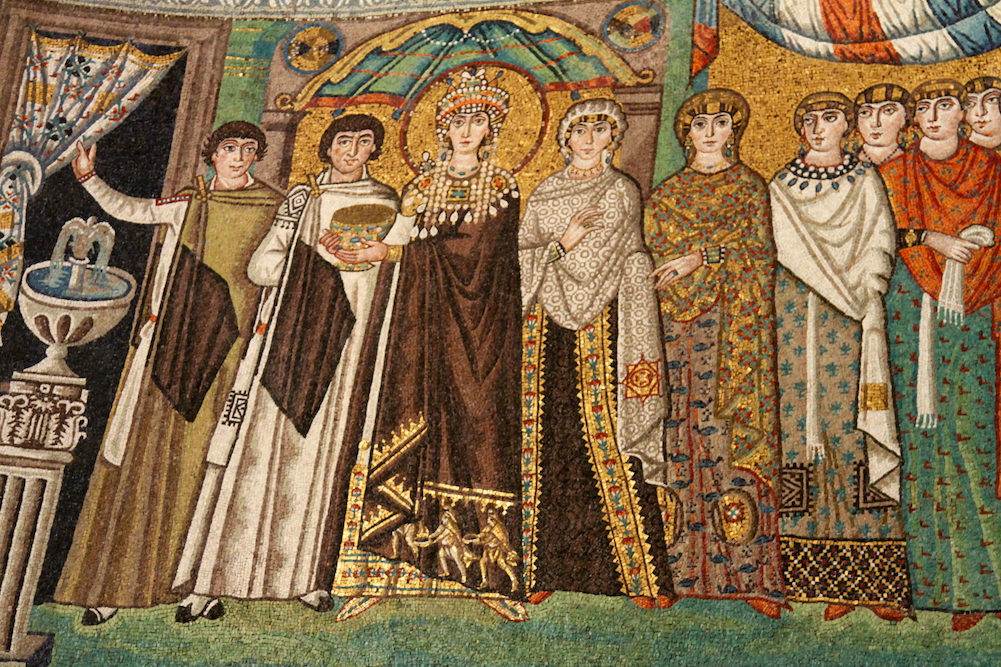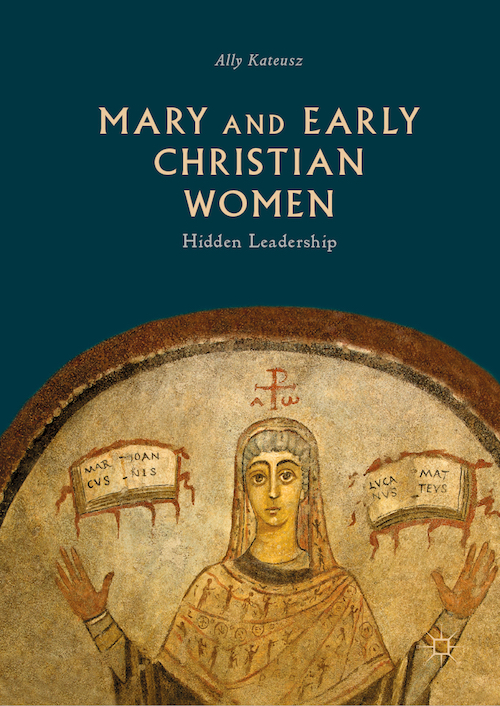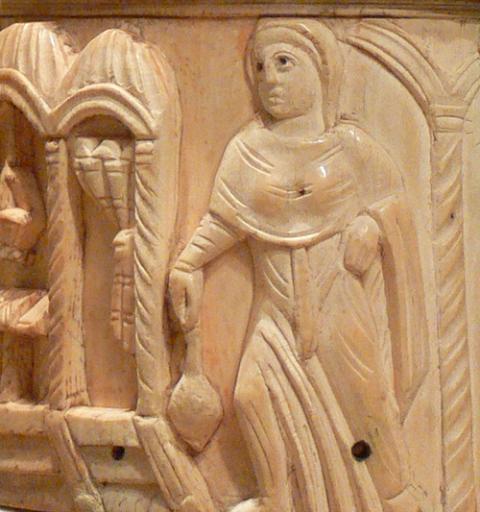
A mosaic near the apse of the Church of San Vitale, Ravenna, Italy, depicts Theodora, consort of the emperor Justinian, holding a golden chalice, another woman holding a eucharistic cloth or maniple, and two other women with fringed cloths tucked into their belts, circa 550 AD. (Wikimedia Commons/Carlo Pelagalli)

In Mary and Early Christian Women: Hidden Leadership, Ally Kateusz has written a passionate tour de force that aims to uncover gender balance in second to 10th-century Christian leadership and worship. This scholarly and highly technical work is not for the faint of heart. Even so, readers searching for evidence that women exercised ecclesial authority in patriarchal Christianity's murky origins will be rewarded.
Analyses of textual evidence
Kateusz's obvious strength is her command of early texts about Mary of Nazareth and other early women leaders. The book's first three chapters show how scribes (often monks re-copying ancient manuscripts over a period of 10 centuries) successively deleted descriptions of liturgical and leadership functions performed by Mary and other women as the male church hierarchy progressively restricted those functions to men.
Contrary to previous scholarly belief, Kateusz's analysis of eight successive versions of the popular third- to 14th-century Dormition narratives — accounts of the life and death of Mary of Nazareth — found that the longer texts are more ancient. These lengthier versions preserved vignettes of Mary with a censer offering incense, raising her hands in prayer and blessing, leading the male apostles in prayer, baptizing women, preaching the Gospel, teaching, healing, performing exorcisms, and sending women forth with books to evangelize the Mediterranean world.
Later scribal copies deleted many — and in some cases most — of the third-century author's portrayals of Mary exercising ecclesial leadership.
Kateusz also analyzed ancient manuscripts about four other Christian women — described as "apostles" — who perform the same ecclesial ministries as male evangelists, including preaching, teaching, baptizing, exorcizing, healing, blessing and evangelizing. Early scribes successively excised narratives about these female ministries as well. The four named women are: Mariamne (Acts of Philip, second to fourth centuries) who most scholars suggest is another name for Mary of Magdala; Irene, whose lengthy eighth-century narrative describes her baptizing in Macedonia and Ephesus in Asia Minor; Nino, a fourth-century woman who converted ancient Iberia (Georgia) and is said to have been ordained by the patriarch of Jerusalem; and the legendary Thecla, whose story suggests that many female evangelists were actively involved building the church in Asia Minor.
Advertisement
Popular narratives such as Thecla's were read aloud in early Christian worship along with readings from the Hebrew and Christian Scriptures. As male hierarchs increasingly suppressed women's ministries, scribes copying earlier texts deleted the now-newly-controversial narratives (such as women baptizing) so the passages could continue to be read at worship.
Analyses of visual evidence
In succeeding chapters, Kateusz turns to visual artifacts to bolster her theses that Mary was understood as a "high priest and bishop," that women were "eucharistic officiants" in the fifth to seventh centuries, and that fifth- to sixth-century catacomb frescos of Cerula and Bitalia in Naples indicate that they were ordained bishops. I find Kateusz's interpretation of visual artifacts less persuasive than her excellent textual analyses. She focuses too narrowly on female priestly ordination, often overlooking cultural explanations of ancient religious motifs found contemporaneously in Greco-Roman society.
For example, she narrowly interprets female orans figures as giving a liturgical blessing and/or signifying Mary. Yet the orans derives from an ancient prayer gesture commonly displayed in non-Christian religious art dating back many centuries B.C. In Roman antiquity, the orans signified the piety and prayerfulness of the deceased, not liturgical leadership. My own work with fourth-century Christian sarcophagi found numerous portrait female orans (and a few male orans) surrounded by biblical stories. These are depictions of the deceased Christian, not Mary.
She also makes much of fifth- to ninth-century artistic depictions of a white strip of cloth that both Mary and various women hold, or wear suspended from their waists, which Kateusz calls a "eucharistic cloth." She suggests the cloth signifies that women officiated at the altar, noting that four to six centuries later a fresco of Pope Clement shows him holding a similar strip of cloth that is now part of the priestly vestment — a maniple.

Detail of an ivory pyx (box for holding the Eucharist) showing women at the altar of the Church of the Resurrection, also called the Anastasis, in Jerusalem, circa 500s A.D. (Metropolitan Museum of Art)
But Kateusz overlooks a persuasive alternative explanation suggested by one of her own sources, the distinguished Byzantine scholar Alexei Lidov, who cites a decree by the sixth-century church council in Auxerre, France: "Women must not accept the Holy Host on a bare hand," and, "All women must have a dominicale (white cloth) to go to communion." He notes these regulations "fixed an ancient and, evidently widespread practice," and "demonstrated the particular piety of women." Sadly, these rules also reveal the increasing hierarchical restriction of female proximity to the sacred.
The author also explores the elevation of Mary, the Mother of Jesus, to what she terms "high priest and bishop." Her hypotheses rest on early writings such as the Protoevangelium of James, which most biblical scholars think was written to counter criticism about the illegitimacy of Jesus. This text depicts Mary among other virgins at the Jerusalem Temple, and in one place shows her entering the holy of holies, where only the high priest could go. The Protoevangelium is not a credible source for historical detail about the life of Mary. For example, the text is so anxious to prove the virgin birth that it describes midwives examining Mary after Jesus is born to affirm that her hymen is still intact. Furthermore, there is no evidence that the Second Temple in Jerusalem ever housed devout "virgins" akin to Rome's vestal virgins.
Still, the Protoevangelium offers important information about what authors and readers were reflecting and saying about Mary during the mid-second century when it is thought to have been written. The narrative attests how quickly the biblical Mary became an icon of the divine for early Christians, many of whom were accustomed to worshipping God in feminine metaphor as well as masculine.
Kateusz also finds visual evidence of Mary's status as a bishop in several mosaics, the most spectacular of which is found at the San Venantius Chapel, Lateran Baptistery in Rome. In this seventh-century mosaic Mary wears what the author identifies as a "pallium," another long thin white garment — this time embellished with a cross — that is partially hidden by Mary's cloak.
Kateusz suggests portraying Mary with a pallium "may have been used to guarantee such roles for women of this era." This thought-provoking speculation is difficult to prove. Mary's pallium does not look like contemporaneous mosaics of bishops' palliums that are worn over the shoulder on their outer garments. The "pallium with cross" on Mary and the mysterious long white strips (without a cross) on other women could also represent the orarion worn by women deacons — which are well attested in literary sources.
As for Cerula and Bitalia, Kateusz's thesis largely depends on the four named Gospel books painted over their heads on their funerary frescos. She cites consecration rituals for bishops in which (a single) Gospel codex was placed over a new bishop's head, but acknowledges it is uncertain when this ritual came to Rome. Kateusz's view that "In Christian art of this, era books were typically associated with bishops" is an oversimplification.
Books and scrolls were common markers of status in Roman art and in funerary art. The Bitalia and Cerula frescos suggest that the deceased women were of high status and educated in Scripture, perhaps pointing to their roles as teachers and proclaimers of the Gospels. Since, according early Christian image specialists such as Janet Tulloch, funerary art is "performative" and "aural" in nature, one could say Bitalia and Cerula wished to be remembered (and perhaps experienced) as teaching and/or preaching the good news to beloved mourners who visited their graves.
Like all art, early Christian art is open to a multiplicity of interpretations. It is unwise to speculate that any given example of early Christian art — especially funerary art — "proves," in the absence of an inscription or a definitive marker of office such as a papal crown, mitre or over-the-shoulder pallium, that a woman (or a man for that matter) held a specific ecclesial office. That said, there is considerable evidence from non-visual sources, both literary and epigraphical (inscriptions), that women held titles of presbyter, deacon and bishop as those roles were understood in late antiquity. Furthermore, it is clear from funerary depictions, textual analyses and biblical scholarship that Christian women did exercise considerable ecclesial authority such as preaching, teaching, hosting eucharistic celebrations, baptizing, exorcising and healing. Wealthy female patrons also financially subsidized the growing church.
In her eagerness to help others see gender balance in early Christian leadership and worship, the author interprets visual imagery in a way that too often extends beyond what the evidence can support. In the absence of an inscription, it is difficult to say on the basis of ancient art alone that any given woman served as a presbyter, deacon or bishop — at least given the present state of scholarship.
Still, Ally Katuesz's meticulous textual analyses should spark a long overdue conversation about the ways women exercising ecclesial authority were edited out of Christian history.
[St. Joseph Sr. Christine Schenk, an NCR board member, served urban families for 18 years as a nurse midwife before co-founding FutureChurch, where she served for 23 years. Her recent book, Crispina and Her Sisters: Women and Authority in Early Christianity, was awarded first place in the history category by the Catholic Press Association. She holds master's degrees in nursing and theology.]







